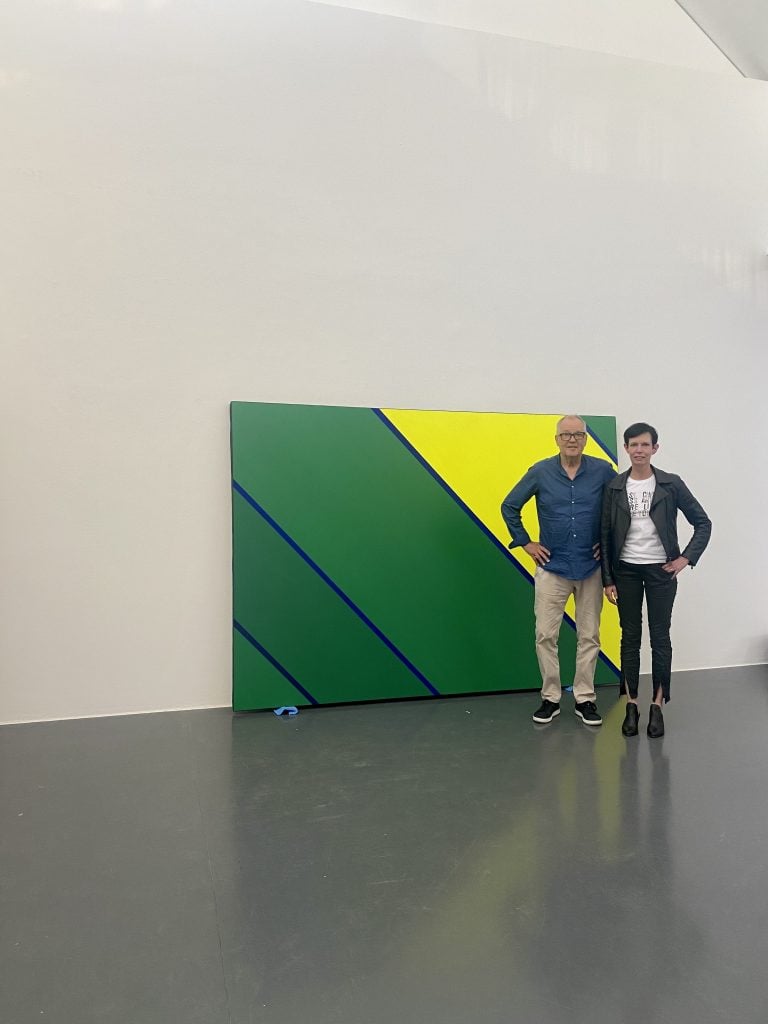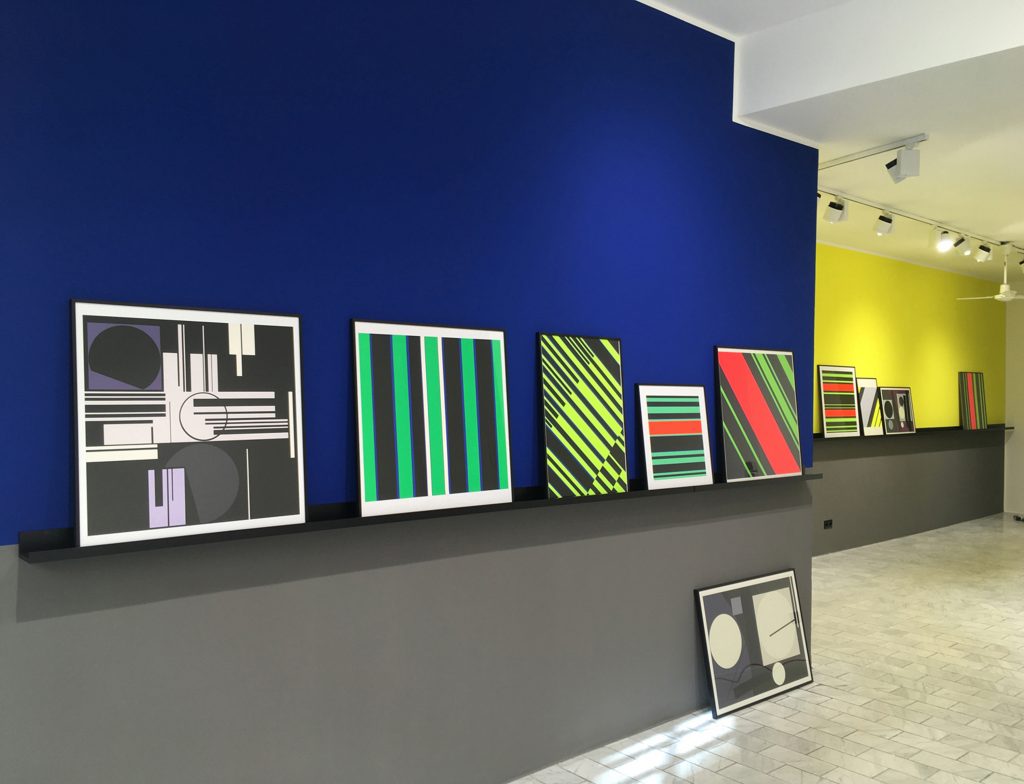Buyer's Guide
This Munich Power Couple Is Shaping the German Art Market
Walter Storms and Caro Jost have just opened their third space in Munich—and it has an interesting concept behind it.

Walter Storms and Caro Jost have just opened their third space in Munich—and it has an interesting concept behind it.

Sophie Neuendorf

Art historian and gallerist Walter Storms and his wife Caro Jost, a successful artist and educated lawyer, are a bonafide art world power couple in Germany. Together the couple has been responsible for shaping the careers of numerous artists and can claim everyone from Günther Uecker to emerging artist Shannon Finley as their intimate friends.
Recently, I had the distinct pleasure of visiting one of their three spaces in Munich and speaking with Storms about the importance of seeing art in real life, digitalization, and the secret to their success.
The UK, US, and Spain are emerging from lockdown with many galleries and museums opening exhibitions. How did the relatively slow reopening in Germany affect the business?
Our Munich spaces were completely closed for a few months, which was very tough. For a time, we didn’t sell anything. It took several weeks for collectors to acclimatize to this new situation and find the courage to purchase art again. After that, to be honest, I observed that our customers, new and current, had an even greater interest in so-called blue chip works, by artists like Günther Uecker or Rupprecht Geiger. Though it has to be said that our collectors truly purchase for passion and only rarely think of art primarily as an alternative investment.
I’m also very proud of our three exhibition spaces; they’re absolutely unique not only in Munich but in Germany. These are incredibly special places where we also enjoy hosting intimate dinners with our artists and collectors. The fact that we opened our third space post-pandemic really shows how important personal encounters are within the art world—regardless of digitalization.
Many within the art industry have turned to online viewings and sales during the pandemic. Have you also embraced digitalization?
The last year has clearly shown that contemporary digital forms of communication are essential for a future-proof gallery. Since travel and art fairs were not possible, we had to rapidly adapt to these conditions and expand our online presence across multiple channels which helped provide accessibility, increase awareness and open up to a wider audience. Can an online viewing room replace the physical experience of encountering an artwork in person? We experienced that collectors have grown comfortable buying art based on a PDF catalogue of artists they know and from a gallery they trust. Astonishingly, we had equal amounts of inquiries from both current and new collectors.
Do you believe that the art industry will change back to the way things were?
I hope it doesn’t, to be honest. You also have to consider the environmental impact of traveling to so many art fairs. We happily reduced our fair attendance to a few important ones, such as Art Cologne, or Art Dubai, or Art Basel. The Armory Show is also great to attend, but covid-19 restrictions forced us to skip it this year.
The reduction in fairs profoundly reduced our costs, and many of our colleagues concur with this. Especially younger galleries take a huge risk in traveling to fairs and are better served selling online. Additionally, over the past few years, fairs turned into places of entertainment, which wasn’t necessarily healthy for the industry. But the meetings in person, at art fairs, are still extremely important, regardless of digitalization and online viewing rooms. It’s impossible to meet so many collectors and art lovers simply within the gallery spaces.
How do you feel about NFTs and cryptocurrencies?
I’ve been reading a lot about NFT’s and now believe that it’s a niche within the art market with potential for the future even though it is still a largely unregulated market at the moment. And to be honest, it’s not the obligation of galleries or collectors to regulate this market—let’s see what governments do. In the end, I believe NFTs and Tokenization are not about art, they’re about investment and money.
Personally, I’m traditional in the sense that I prefer to own the entire physical artwork, not only a tiny piece of it.

Courtesy of Galerie Walter Storms.
How do you select the artists for your gallery?
When you’ve been in the business for as many years as we have, one develops a sense of what is good and what reflects the zeitgeist. Most of the artists we represent are from the academy. Even though we have focused on European artists, we regularly expand our portfolio to include artists beyond Europe. We love going to studios around the world to discover emerging artists, speaking with them, learning about what motivates them. For example, we just signed Nathan Randall Green from New York. He works well within the gallery in terms of his personality but also in the sense of how his work reflects our times.
If we noticed that an artist only creates work to please the market, then that would be extremely uninteresting for us. I’m primarily fascinated by the background, what motivates and moves an artist. It’s not only about an artist’s talent or potential in terms of the canon, but also very much about having a personal connection. We spend a lot of time with them, party with them, and take them for dinners at home. We become a family.
You have shown at several international art fairs, such as Arco Madrid and Art Basel. What is the main difference between collectors in Germany and those abroad?
We oversee several large private collections and are well-acquainted with the owners, of course. But it really depends on the personality of the collector—with some friendships develop while others prefer a business relationship. But that’s across the board, I can’t say that I’ve noticed differences across nationalities. I can say, however, that there are regional differences within Germany. Collectors from Cologne are very spontaneous and quick; Bavarians are more serious and deep.
You’re friends with Günther Uecker, an artist you represent. What is the friendship between a gallerist and artist like?
I think it really depends on the gallerist’s personality. For me, there is much more between artists and gallery owners than just a business relationship. I’m a Rhineländer and we like to have fun, to eat well, and drink well. I’ve been close friends with Uecker my whole life, since my school days, and we’ve taken many trips together. We spend most of our summers together. To put it bluntly, if an artist is a horrible person, then I won’t represent him or her at the gallery. I would like to be friends with all the artists I represent. Handshake deals used to be like a contract in the good old days. Now, you need a contract. But a lot of trust can be engendered by good friendships.
Uecker dislikes being reduced to only his nail works. Are you hoping to present another side of his oeuvre?
It’s absolutely his decision what he works on. For example, he recently presented his “Lichtbögen” Corona series” in Paris and I am just showing his monumental “Word Pictures”. Uecker has a theme which is about how humans injure and violate themselves and each other. Especially in the context of the different religions. And this theme can be seen in all of his work, regardless of the form his work takes.
You work closely with your wife, how is the working relationship?
It’s 24/7. Well, we truly make all of the major decisions together. We really work to complement each other’s strengths and are a team. It’s a wonderful symbiosis and I am convinced that the real secret to our success, over the many years, is our intimate working relationship.
Most recently, you opened a new space in Munich. Why did you decide to take this step, and why now, post pandemic?
I purchased the estate of Günter Fruhtrunk and thus decided to dedicate our just opened third space in Munich-Maxvorstadt entirely to the graphic work of this important artist. His geometric-abstract work is phenomenal. We are very excited about our new location—which is a mix of both an exhibition space as well as a concept store. It will be akin to what Keith Haring did in New York or Murakami in Tokyo. In two years, we will mark his centenary of the artist’s birth with exhibitions in Paris, Bonn and Munich. The concept store and exhibition space are kind of like a preview of our plans in terms of his centenary.